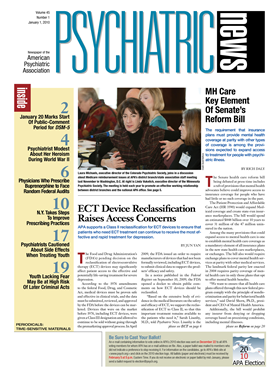Prevention of mental illness would appear to have “arrived,” with research that began decades ago beginning to bear fruit.
But the concept is not new and has generated skepticism since the early 1960s when the community mental health movement adopted prevention as an ideology, with little science to back it up.
“Psychiatrists, for a variety of reasons, have not until fairly recently had a developmental perspective on the illnesses they treat,” said psychiatrist Sheppard Kellam, M.D., an emeritus professor at Johns Hopkins University Bloomberg School of Public Health, whose career has been devoted to research on mental illness prevention. “It goes back to a period when we did not have any data on the origins and developmental course of factors leading to pathology. We didn't even know if depression had its antecedents in childhood depression.”
In the late 1960s, Kellam and other researchers—such as Lee Robins, Ph.D., who was a professor of social science in psychiatry at Washington University in St. Louis, and Michael Sheppard, Ph.D., a professor of social work at the University of Plymouth in the United Kingdom, among others—began to address the dearth of science on antecedents of mental illness.
“We started to do research with people who experienced problems in adulthood, looking retrospectively at what they were like compared to their classmates,” Kellam said. “Later we began doing longitudinal developmental epidemiologic studies in which we followed cohorts of children over a significant span of their life course within a circumscribed community to determine the trajectories that led to problem outcomes.”
He is also a senior research fellow at the American Institutes for Research and director of prevention research centers at Johns Hopkins University School of Medicine.
Kellam says the science underlying prevention has now matured, yielding interventions across the continuum from primary to tertiary prevention. These include what the Institute of Medicine refers to as “indicated” preventive interventions that target high-risk individuals who have not crossed the threshold into clinical pathology, “selective” interventions that target nonsymptomatic but increased-risk populations, and “universal” interventions aimed at total populations.
Indicated preventive strategies aimed at targeting high-risk individuals have received the attention of National Institute of Mental Health (NIMH) Director Thomas Insel, M.D. One such effort is the Portland Identification and Early Referral (PIER) Program in Portland, Maine, directed by psychiatrist William McFarland, M.D., which strives to identify and treat persons at very high risk of psychosis who have not yet had an acute psychotic episode (Psychiatric News, May 2, 2008).
In a February 2009 editorial in the Archives of General Psychiatry, Insel highlighted the potential of what he called “preemptive” treatment of schizophrenia that targets individuals with risk factors such as family history combined with unusual thoughts and changes in social functioning.
NIMH has been less receptive to broad-based, universal, public-health prevention efforts. But Kellam says there is an impressive body of research that has come to fruition after decades of work showing that universal interventions directed at early risk factors can be efficacious.
One such universal, school-based intervention, known as the Good Behavior Game, has shown preventive effects on several psychiatric disorders by young adulthood, he said.
Kellam was an editor and contributing author for a supplemental issue of the journal Drug and Alcohol Dependence, published by the National Institute on Drug Abuse in 2008, describing longitudinal epidemiologic studies of the impact of the Good Behavior Game on a range of adult behavioral and social outcomes.
(The game is directed at socializing children to the role of student and focuses on one particular early behavior shown to be a consistent early antecedent to a broad set of adolescent and adult diagnoses involving externalizing behaviors—namely, early aggressive and disruptive classroom behavior.)
The first study looked at the effect of the game in first- and second-grade classrooms in 19 Baltimore public schools beginning in the 1985-1986 school year. In five poor to lower-middle-class, mainly African-American urban areas, three or four schools were grouped, and within each set, schools were randomly assigned to one of three conditions: the Good Behavior Game, a curriculum-and-instruction program directed at reading achievement, or the standard program.
When assessed in young adulthood, male participants in the game, particularly those in first grade who were more aggressive and disruptive, showed significantly less prevalence of the externalizing outcomes cited above.
Kellam believes that these suggest that the full range of prevention efforts—universal, selective, and indicated—is ready for prime time and deserves the attention of psychiatry. “The question now is, Can you address an intervention toward early risk factors and produce a long-term effect that reduces the impact of later disorders,” he said.
An abstract of “Effects of a Universal Classroom Behavior Management Program in First and Second Grades on Young Adult Behavioral, Psychiatric, and Social Outcomes” is posted at <www.ncbi.nlm.nih.gov/pubmed/18343607>. 

